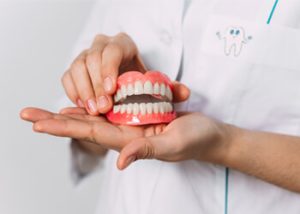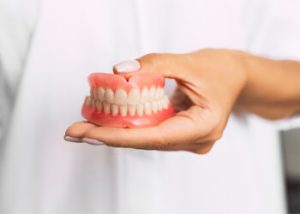Relining Of Denture — Everything You Need To Know

If your dentures have been bothering you lately, it may be time to get them relined. This process involves your dental practitioner adjusting the base of your prosthesis so that it fits better and is more comfortable. It’s relatively quick and easy and can make a big difference in how you feel about wearing your dentures. Denture relining is a more convenient and less expensive alternative to denture replacement, and it can often be completed in just one day.
In this post, we will explain how the denture reline process improves patient comfort and fit.
The Denture Reline Procedure: Why It’s Done
Losing teeth isn’t just aesthetically unappealing; it can also cause long-term damage to your gums. Once you wear dentures, the underlying bone used to support tooth roots starts deteriorating because there’s nothing left to anchor it. If you lose mass in your jawbone, the gum tissue surrounding it will also change shape. This means that the dentures you had initially fitted will not fit as snugly around your gums. By getting a denture relining, you can save money from having to get an entirely new prosthesis. Plus, it provides extra comfort by ensuring that your fit is snug.
Over time, your prosthesis may stop fitting as well due to normal wear and tear or microcracks, meaning you may need a denture reline.
If you’re experiencing any discomfort from your dentures, it’s important to have them relined as soon as possible. Ignoring the problem can lead to bigger issues such as ulcers, fungal infections, and overgrowth of tissues.
What To Expect From Denture Reline
If your dentures are bothersome or move around when you talk or eat, see your dentist as soon as possible. They will evaluate the amount of irritation in your mouth.
If you experience a lot of irritation, your dentist may give you a temporary reline and ask that you return later for the permanent reline.
How Does Permanent Denture Relining Work?
Your dentist will begin by removing and cleaning your dentures. Next, they’ll take away a tiny amount from the plate. The goal is to focus on the root of the problem areas in your mouth causing you discomfort.
 Finally, your dentures will be fitted with a soft or hard resin. But before the resin can set, you need to bite down on the dentures so your dentist can get an impression of your mouth’s contours.
Finally, your dentures will be fitted with a soft or hard resin. But before the resin can set, you need to bite down on the dentures so your dentist can get an impression of your mouth’s contours.
In short, the process improves painful or uncomfortable areas in your mouth by adding extra material. Additionally, it can fix prostheses that are damaged or broken.
Dentures can be relined in-office by most dental practices; however, if extensive changes are needed, your denture might need to be sent to a dental laboratory.
How Long Does A Denture Reline Take?
In 30 to 60 minutes, a soft denture reline can be completed; however, the denture won’t last as long as one that has undergone a hard reline. Soft relines last from 12 to 18 months based on individual circumstances.
If you need a hard denture reline, the process may take up to two days if your prosthesis is sent to a dental laboratory. It may take a little less time if your dentist can reline the denture in their clinic.
Since a hard denture reline uses a material that becomes a part of the acrylic denture, you can anticipate it to have the same lifespan as the dental appliance.
What Are The Benefits Of Relining Denture?
There are several different ways that relining can benefit you.
Cleaner Mouth
If your dentures are loose-fitting, they can create gaps between the denture material and your mouth tissue. These gaps can trap small food pieces. When food becomes trapped in your teeth, it can rot and produce bad breath. If decay is left unchecked, it could also lead to infection. A denture that fits properly will help prevent food from getting trapped behind the dentures and causing more problems.
Avoiding Breakages
Dentures that fit poorly will move while you are wearing them. Dentures are designed to distribute pressure evenly throughout the denture plate. If your dentures are moving, it will put pressure on particular parts of the denture, which eventually might cause the denture to crack. The likelihood that the denture will develop problems increases if it is constantly flexed. Any damage to the dentures, such as chips or cracks, should be fixed immediately.
 Better Fit
Better Fit
The primary purpose of denture relining is to keep a proper fit. A denture that slides and moves makes it hard to chew and talk. Furthermore, the movement will generate sore spots in your mouth, causing discomfort. Many denture wearers are unaware that their discomfort is due to an improper fit. A well-fitted denture should not cause any pain. A good fit is essential for denture wearers to get the best experience.
How to Clean Relined Dentures?
There are only a few differences between cleaning a relined denture and cleaning other types of dentures. A hard relined denture can be cleaned the same way as you would typically clean a new denture; remember to never scrub it with a brush that has stiff bristles or toothpaste (which is abrasive). Be extra careful with temporary and soft-relined dentures for at least 72 hours until the relining material sets. Neither of these kinds of relines should be soaked overnight in the denture cleaning solution, as this will damage the delicate lining.
To remove food particles, you only need to brush under running water that is cool to warm with a soft brush.
Schedule a Denture Reline at My Local Dentists
If you’re experiencing any pain or gum irritation with your dentures, please let us know as soon as possible. We will be happy to help get them back in proper working order. Relining your dentures is an effective way to improve the fit and function of your teeth. Contact My Local Dentists today.
Note: Any surgical or invasive procedure carries risks. Before proceeding, you should seek a second opinion from an appropriately qualified health practitioner.
References
All About Relining Dentures
https://www.colgate.com/en-us/oral-health/dentures/all-about-relining-dentures#
First Denture Reline and Repair: What to Expect
https://eurodenture.com/blog/happens-get-denture-repair-denture-reline/
